OnePlus 2 Review
OnePlus proudly boasts that its latest smartphone is a "flagship killer." Does the OnePlus 2 have the arsenal to slay its competitors or is its metal chassis just filled with hot air?
Why you can trust Tom's Hardware
Camera Performance And Photo Quality
In a market where smartphone cameras continue to increase in megapixels, OnePlus touts the other qualities of its camera, stating that "megapixels fail to tell the whole story." It's time to put this claim to the test as we pit the OnePlus 2 against some of the best phones available, including the Samsung Galaxy S6, iPhone 6s Plus, LG G4, Motorola Moto X Pure Edition, and the previous generation OnePlus One. The iPhone 6s Plus uses a 12 MP sensor, while the OnePlus One matches the the OnePlus 2's 13 MP camera resolution. Both the Galaxy S6 and LG G4 use 16 MP sensors, while the Moto X uses a 21 MP sensor.
All of the images shown below were taken using the phone's default camera app set to auto mode unless noted. Also, you can view the full-sized image for each photo by clicking the text links below the images that are within a slideshow album. The Galaxy S6 and LG G4 capture images natively at a 16:9 aspect ratio, while the iPhone 6s Plus, Moto X Pure Edition, OnePlus One, and OnePlus 2 all shoot natively with a 4:3 aspect ratio. It should be noted that while the LG G4 does shoot natively at 16 MP with 16:9 aspect ratio, most of the G4's pictures were taken with a 4:3 aspect ratio. This does not impact the quality of the G4's pictures, since it just crops the edges of the frame. Also, our Galaxy S6 uses the Sony Exmor RS IMX240 image sensor, which we've shown to produce better images than the alternate Samsung S5K2P2 ISOCELL sensor.
Outdoors
Daylight
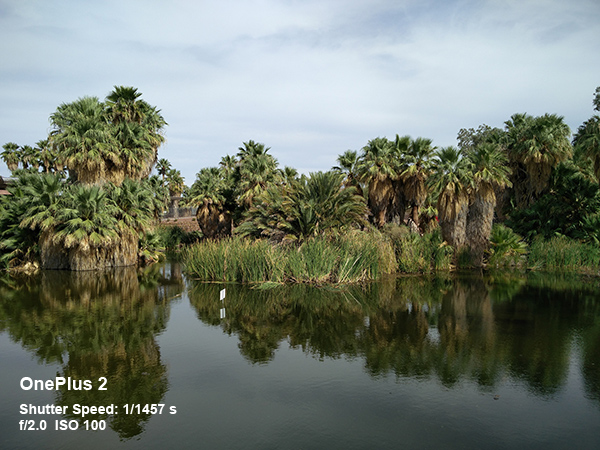
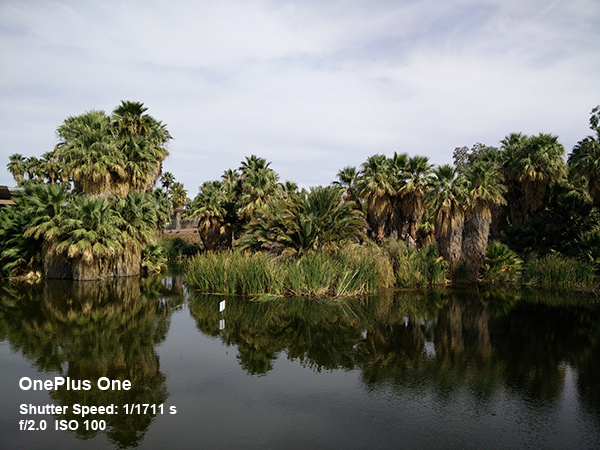

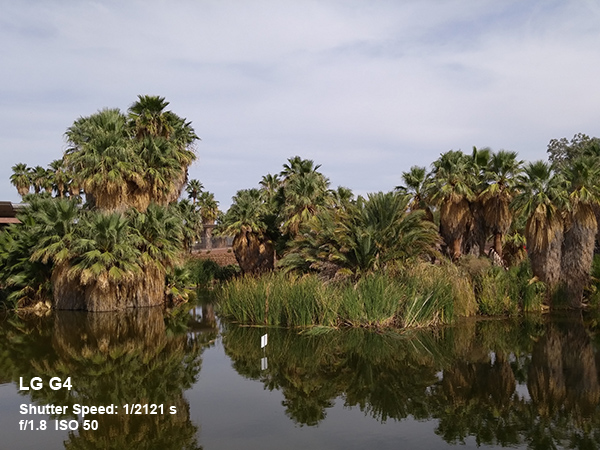
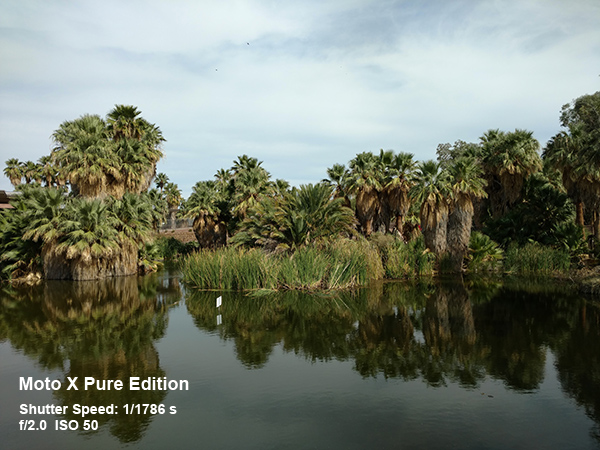
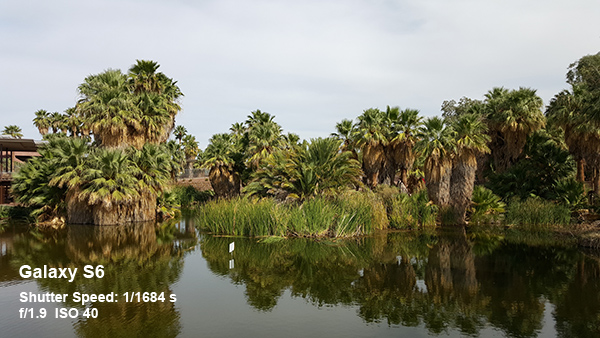
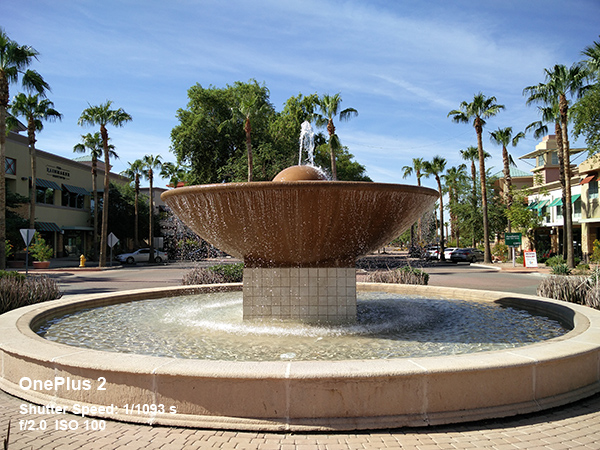
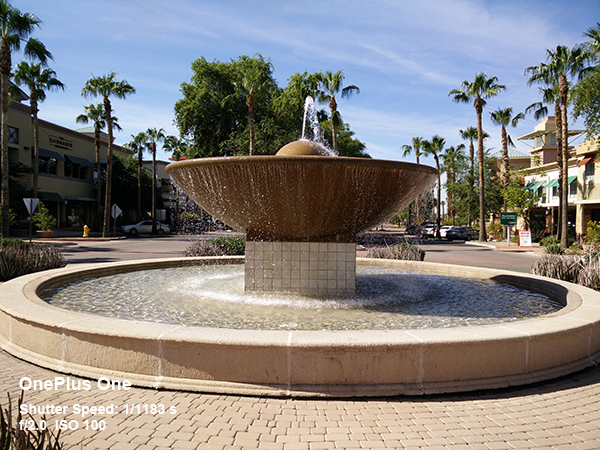
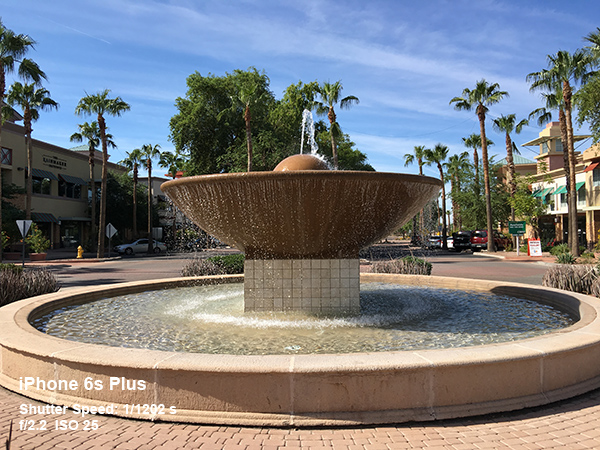

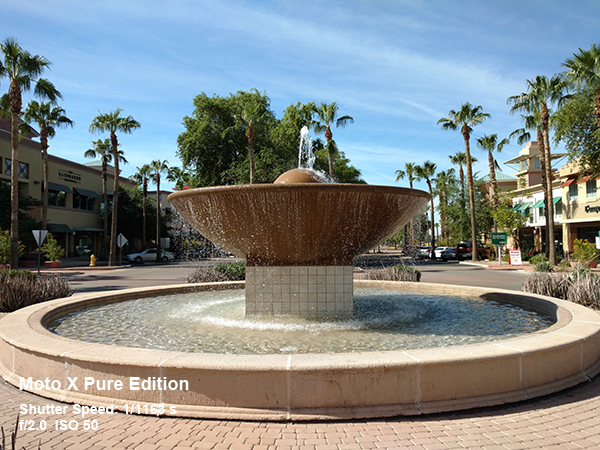
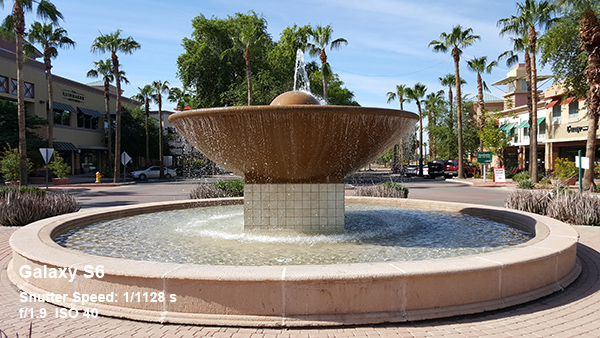
Full-Size Images: [OnePlus 2: daylight lake], [OnePlus One: daylight lake], [iPhone 6s Plus: daylight lake], [LG G4: daylight lake], [Moto X Pure Edition: daylight lake], [Galaxy S6: daylight lake], [OnePlus 2: daylight fountain], [OnePlus One: daylight fountain], [iPhone 6s Plus: daylight fountain], [LG G4: daylight fountain], [Moto X Pure Edition: daylight fountain], [Galaxy S6: daylight fountain]
In the first set of images there's plenty of light and all cameras select ISOs of 100 or less with fast shutter speeds, leading to mostly good exposures across the board. However, the G4 produces a darker image despite its larger aperture. The iPhone 6s Plus produces the brightest image, while the OnePlus 2 and OnePlus One fall in the middle.
Both the OnePlus 2 and iPhone 6s Plus come very close to the ideal white balance. Colors in the OnePlus One and G4 images skew too warm, giving the clouds a red tint. In the image from the Galaxy S6, the grasses and palm fronds near the center are a shade of green verging on yellow as opposed to the more natural muted green seen in the rest of the images.
The OnePlus 2's image shows less noise than the OnePlus One's, while still preserving more detail. It's just the opposite when comparing it to the Moto X Pure Edition, which shows less noise grain than the OnePlus 2, but smoothes away detail like the ripples on the water. The Galaxy S6 sits at the other end of the scale, showing both less noise and more detail than the OnePlus 2.
Get Tom's Hardware's best news and in-depth reviews, straight to your inbox.
Most smartphone cameras apply an edge sharpening filter and the OnePlus 2 is no exception. Its filter does seem to be a bit more aggressive than normal, similar to the iPhone 6s Plus, but it's not so aggressive as to cause unwanted artifacts. What really hurts image quality is the relatively high level of JPEG image compression the OnePlus 2 uses. This is most evident in the sky around the perimeter of the trees where compression artifacts are clearly visible.
In the second set of images featuring the water fountain, the Galaxy S6 produces the best image again. It gets the exposure correct and white balance perfect, with virtually no image noise. The OnePlus 2 also does well in this scene: exposure is good and white balance is nearly perfect, certainly better than both the OnePlus One and iPhone 6s Plus whose warm tone gives the clouds a red tint. The OnePlus 2 again shows far less noise than the OnePlus One in the sky and on the buildings. It even shows less noise than the iPhone 6s Plus. This is even more impressive considering it avoids the noise reduction artifacts evident in the iPhone’s image, and it does not smear away detail like the Moto X's noise reduction does with the bricks in the road or the word at the bottom of the white yogurt sign. JPEG compression artifacts are once again clearly visible in the OnePlus 2's image on the same sign.
Evening
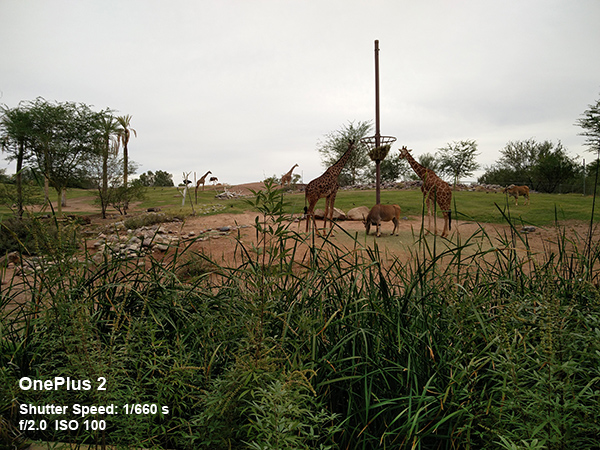
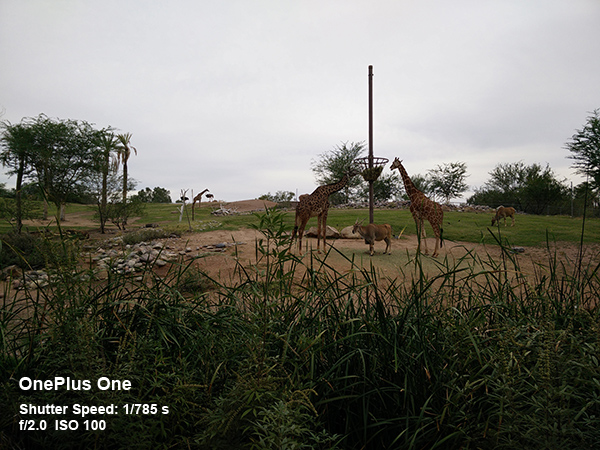
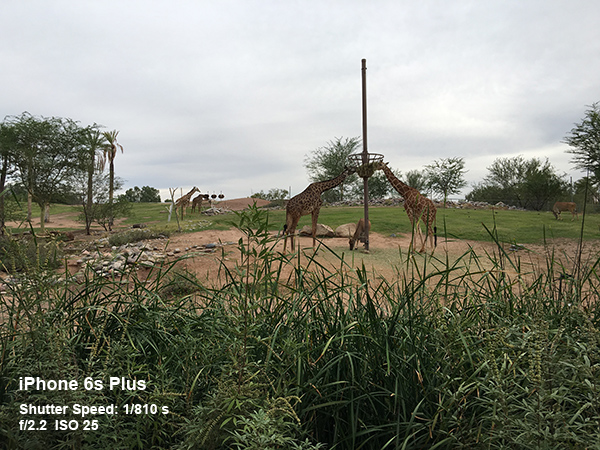
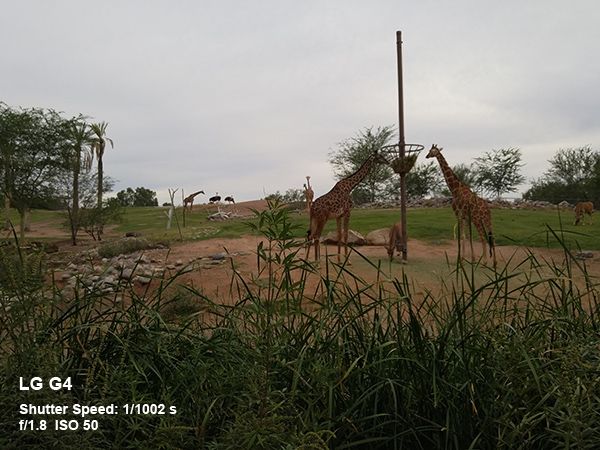
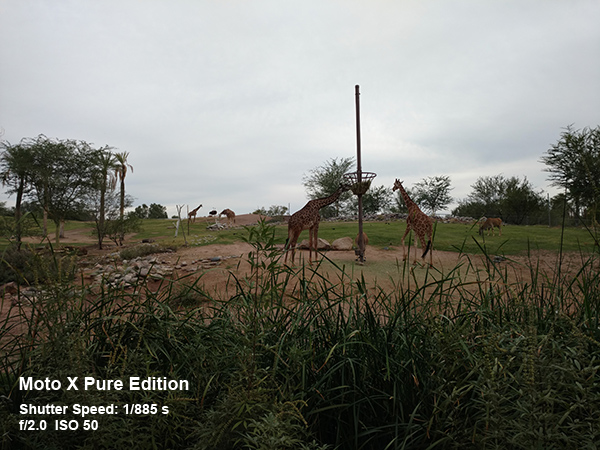

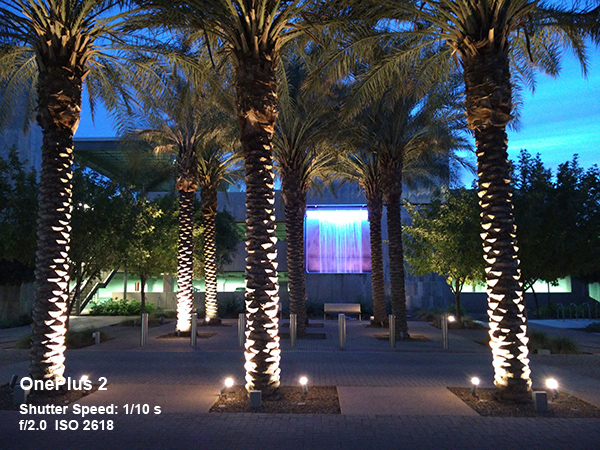
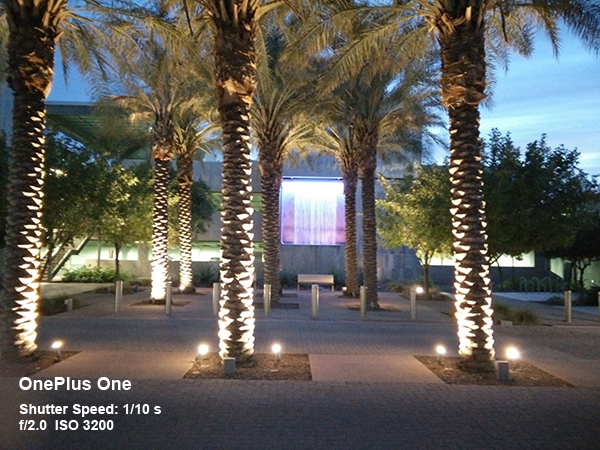
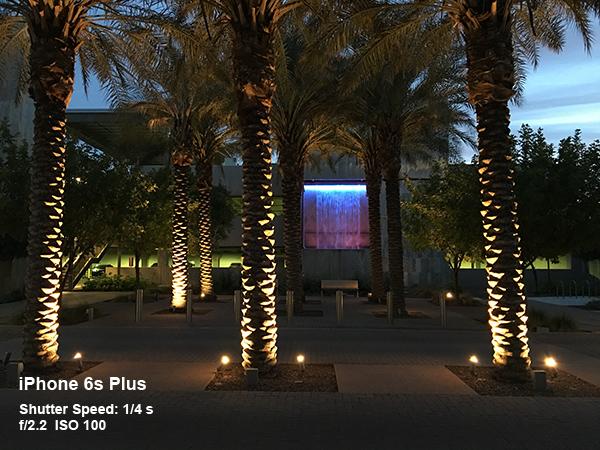
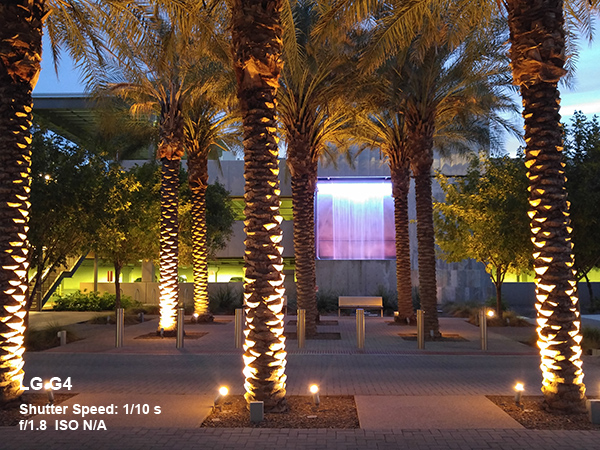

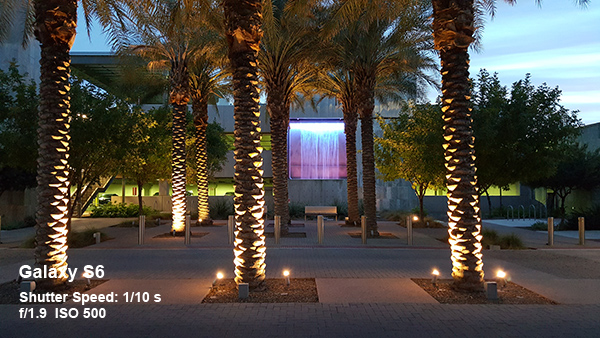
Full-Size Images: [OnePlus 2: afternoon giraffes], [OnePlus One: afternoon giraffes], [iPhone 6s Plus: afternoon giraffes], [LG G4: afternoon giraffes], [Moto X Pure Edition: afternoon giraffes], [Galaxy S6: afternoon giraffes], [OnePlus 2: night trees], [OnePlus One: night trees], [iPhone 6s Plus: night trees], [LG G4: night trees], [Moto X Pure Edition: night trees], [Galaxy S6: night trees]
The first set of images were taken in the afternoon under an overcast sky. In this challenging condition, the G4 uses the fastest shutter speed of the group and produces an overly dark image, similar to the OnePlus One and Moto X Pure Edition. Both the OnePlus 2 and iPhone 6s Plus take advantage of OIS and opt for a longer exposure, resulting in much brighter images.
The OnePlus 2 and Galaxy S6 do a good job adjusting the white balance and capturing rich looking colors, while the overcast sky causes the iPhone 6s Plus and Moto X Pure Edition to select a cooler white balance.
Zooming in reveals some flaws in the OnePlus 2 image. Noise is reasonably low, avoiding the significant chroma noise in the OnePlus One image, although it cannot match the Galaxy S6. As light levels begin to drop off, the OnePlus 2 begins to lean more heavily on its noise reduction algorithm. Detail in the grass is smeared away as is some of the fence in the background. It’s not nearly as bad as the Moto X, but a little worse than the iPhone 6s Plus. The OnePlus 2’s noise reduction also causes some haloing around objects, but this is only visible if you’re looking for it. It’s difficult to make comparisons to the G4 because the camera always focused on the plants in front, leaving everything behind, including the giraffes, blurry.
With the sun just dipping below the horizon in the second set of images with the palm trees, the cameras have very little light to work with and struggle balancing bright lights, shadows, and the sky. The OnePlus One has the most issues; it’s unable to focus correctly even after multiple attempts and pushes ISO the highest of the tested cameras to improve brightness, resulting in the noisiest image of the set.
The OnePlus 2 has trouble focusing as well despite the use of its laser. It ends up with a good deal of noise due to its high ISO setting and sets the coolest white balance of the group: the light on the tree trunks appears more harsh, the parking garage lights appear a pale green instead of yellow, and the sky is an unnatural shade of blue. The noise, white balance, and focusing issues place the OnePlus 2 towards the back of the pack in this low-light scene, but it's definitely an upgrade over the OnePlus One.
HDR
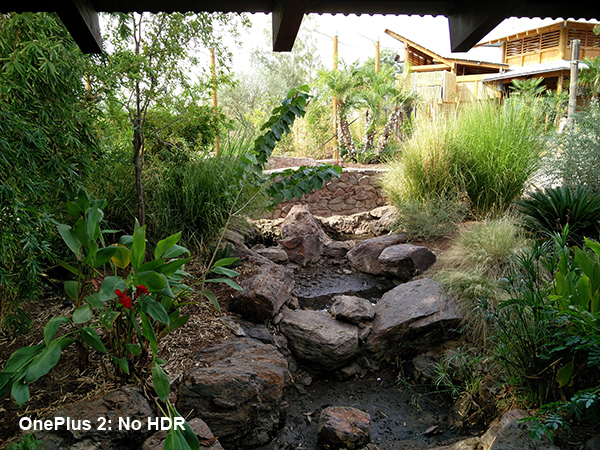
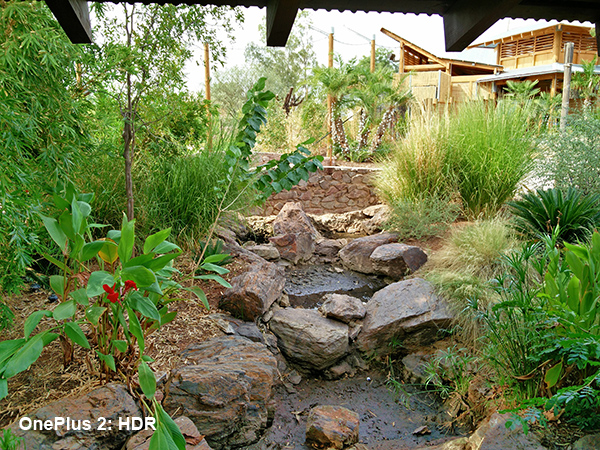


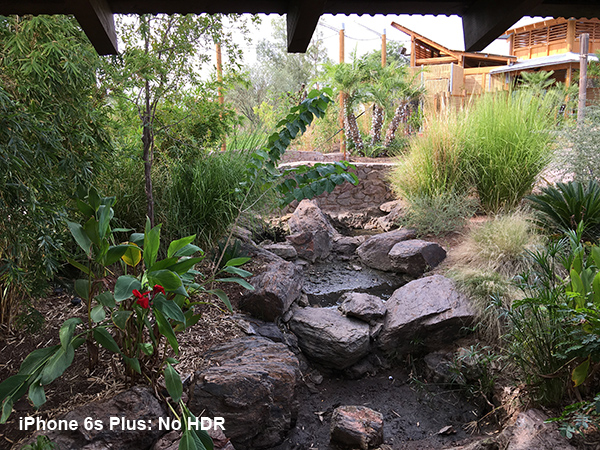
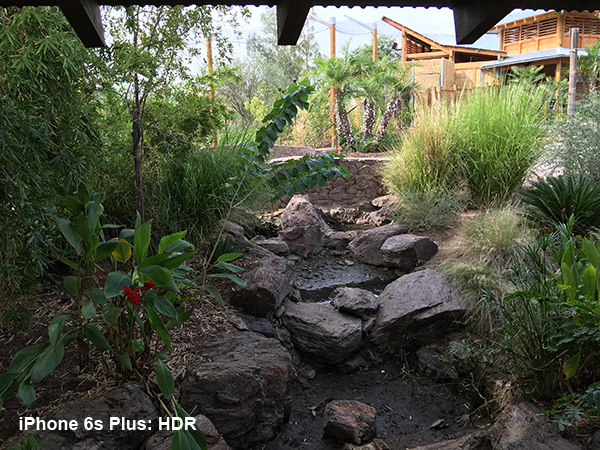
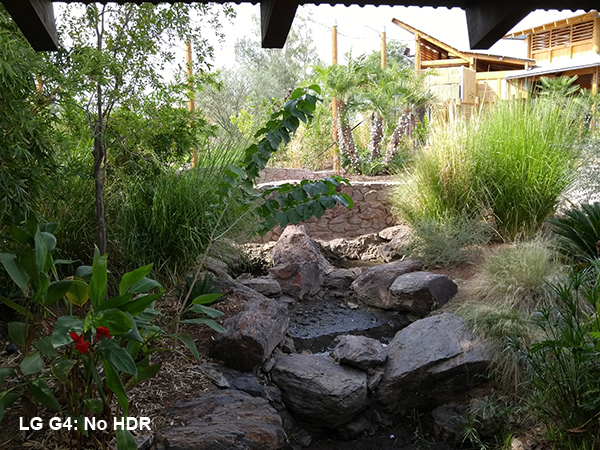

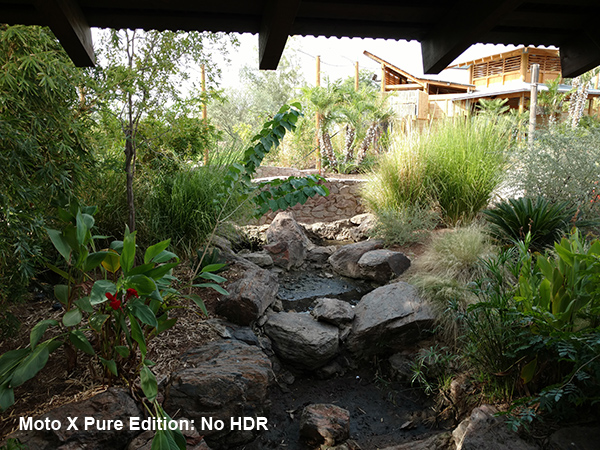
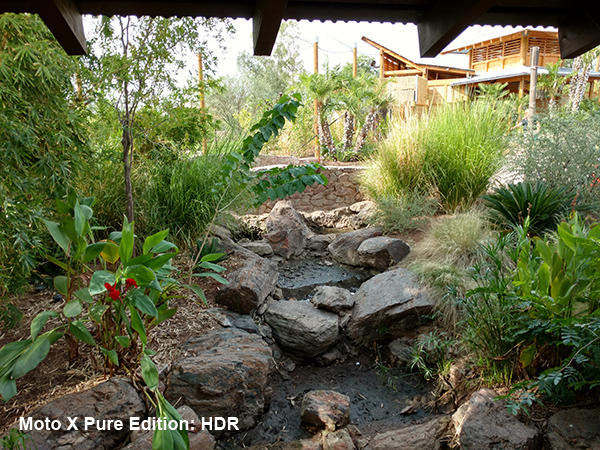
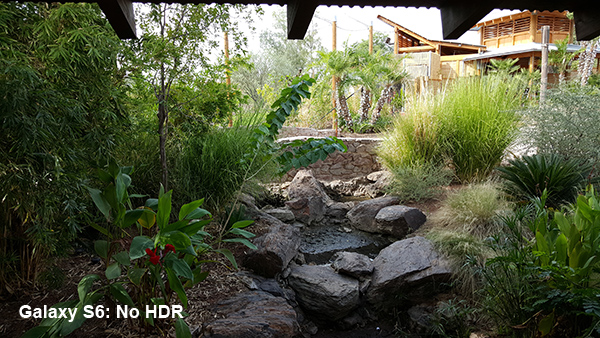
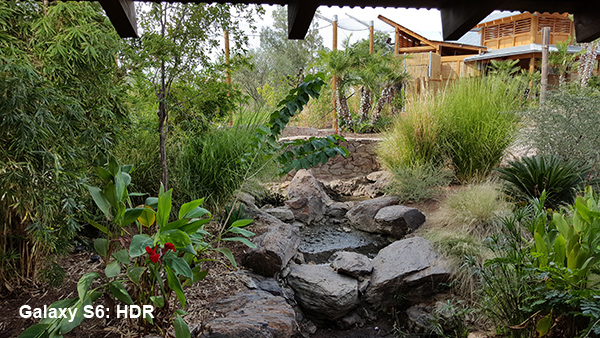
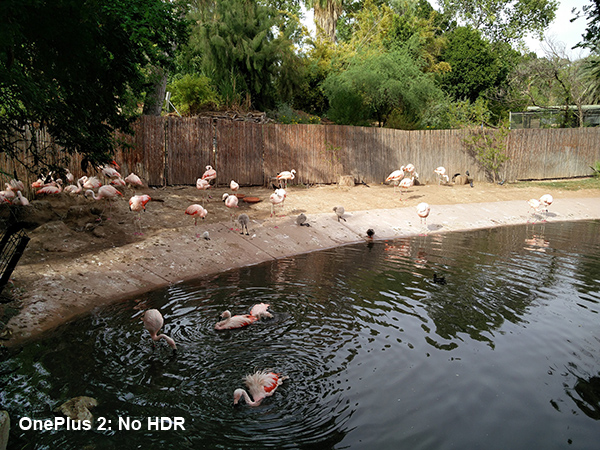
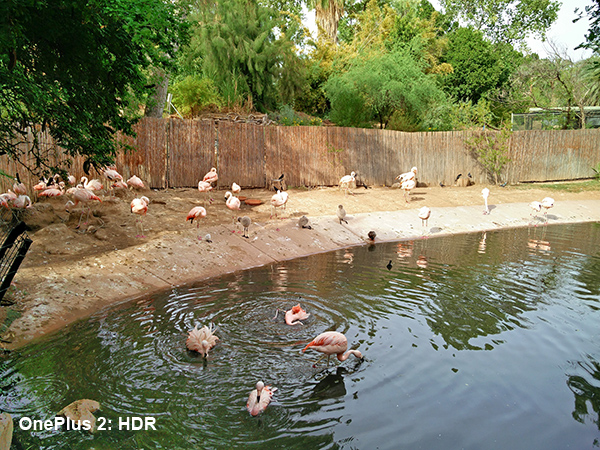
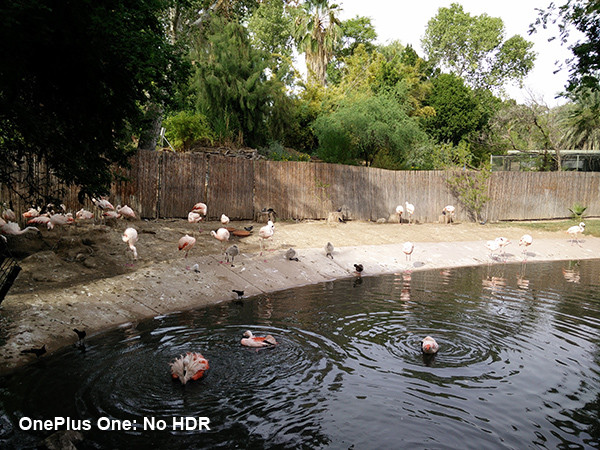

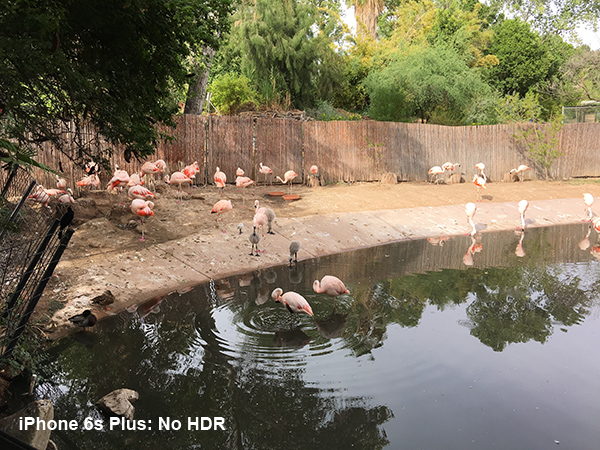
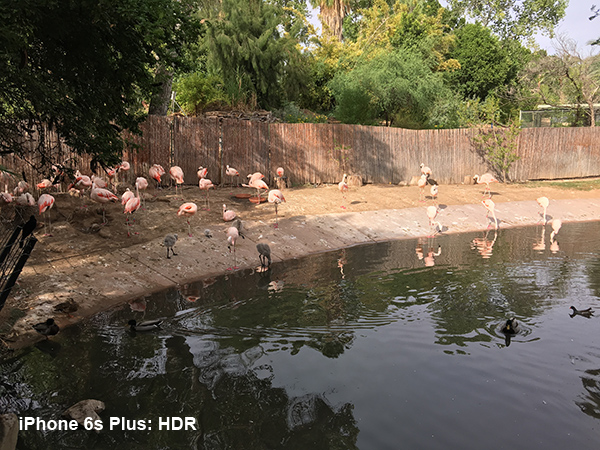

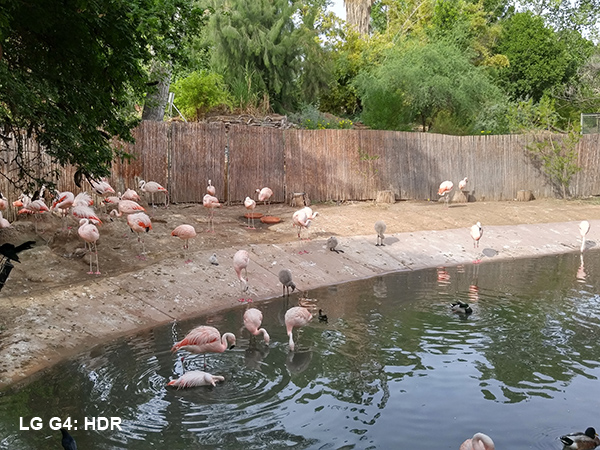
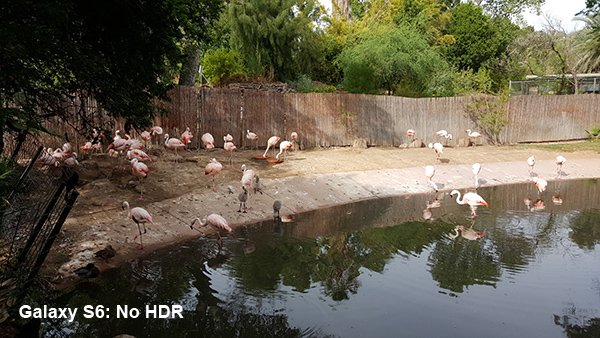

Full-Size Images: [OnePlus 2: stream - no HDR], [OnePlus 2: stream - HDR], [OnePlus One: stream - no HDR], [OnePlus One: stream - HDR], [iPhone 6s Plus: stream - no HDR], [iPhone 6s Plus: stream - HDR], [LG G4: stream - no HDR], [LG G4: stream - HDR], [Moto X Pure Edition: stream - no HDR], [Moto X Pure Edition: stream - HDR], [Galaxy S6: stream - no HDR], [Galaxy S6: stream - HDR], [OnePlus 2: flamingos - no HDR], [OnePlus 2: flamingos - HDR], [OnePlus One: flamingos - no HDR], [OnePlus One: flamingos - HDR], [iPhone 6s Plus: flamingos - no HDR], [iPhone 6s Plus: flamingos - HDR], [LG G4: flamingos - no HDR], [LG G4: flamingos - HDR], [Galaxy S6: flamingos - no HDR], [Galaxy S6: flamingos - HDR]
High dynamic range (HDR) imaging is useful for achieving good overall exposure when shooting scenes with a mixture of bright lights and shadows. The OnePlus 2's HDR mode is a bit too aggressive when lightening shadows, making darker areas look almost as though they are in direct sunlight, and too conservative with highlights, failing to remove the glare from the roof of the building and tone down the bright sky. There is also purple fringing visible on the edges of the roof overhang and some minor ghosting with leaves in the upper-left corner caused by a light breeze and too much time taken between different exposures. At the other end of the scale is the iPhone 6s Plus. Its HDR mode focuses on the brighter portions of the image, keeping the sky from being blown out and revealing the netting in the background. While it does well reducing glare, it ends up making the shadows even darker. There's also some purple fringing on the edges of the roof, although, it’s not quite as noticeable as it is on the OnePlus 2.
Like the OnePlus 2, the LG G4 and Moto X Pure Edition brighten the shadows but do nothing to reduce the overly bright sky. Both phones produce a more natural looking image, though. The Moto X does exhibit more purple fringing than the OnePlus 2 and it loses some of its detail. The Galaxy S6 produces the best overall HDR image, with even exposure across all areas.
The same qualities are present in the set of images featuring the flamingos. The OnePlus 2 again adds an unnatural degree of brightness, causing the trees to appear almost artificial. There’s some motion ghosting as a result of the overly long exposure, some softening of detail in the foliage, and some purple fringing present on the water ripples. Overall, the OnePlus 2's HDR mode creates images that look far too processed.
Indoors
The staged indoor shots below were lit by overhead LED lights, a CFL lamp from the front, and an incandescent overhead light in the background.
Bright Light


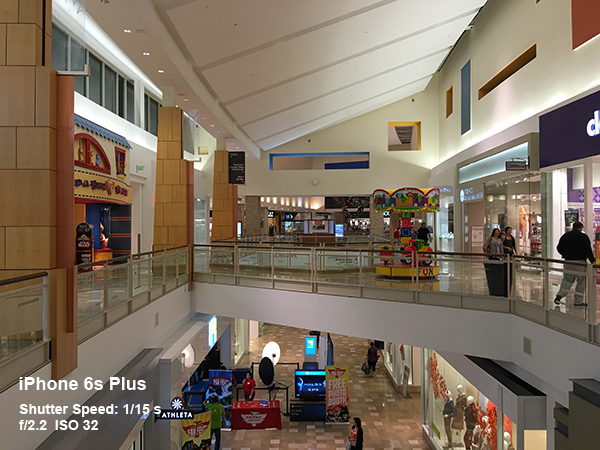
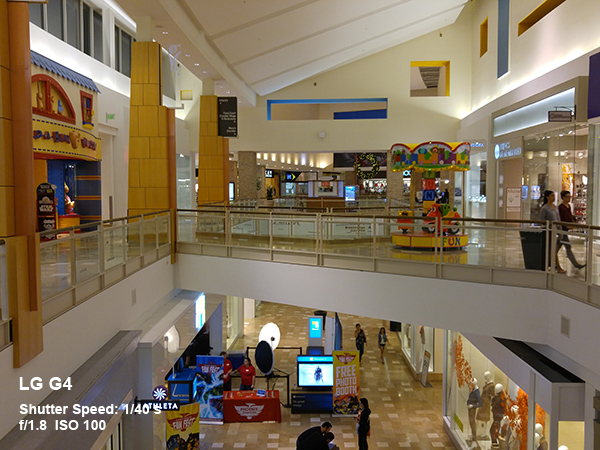








Full-Size Images: [OnePlus 2: indoor mall], [OnePlus One: indoor mall], [iPhone 6s Plus: indoor mall], [LG G4: indoor mall], [Moto X Pure Edition: indoor mall], [Galaxy S6: indoor mall], [OnePlus 2: indoor bright], [OnePlus One: indoor bright], [iPhone 6s Plus: indoor bright], [LG G4: indoor bright], [Moto X Pure Edition: indoor bright], [Galaxy S6: indoor bright]
Taking the cameras inside a shopping mall results mainly in differences with white balance and noise. The Galaxy S6 has the best white balance, but the OnePlus 2 is close behind; its image shows only a very slight red tint. The iPhone 6s Plus, LG G4, and Moto X Pure Edition are all a little further off and lean toward a cooler white balance. The OnePlus One lacks OIS and pushes ISO higher to compensate, producing the noisiest image of the group and blurring out some details in signs. The OnePlus 2 avoids the excessive noise issue of its predecessor, and while noise is visible, it’s not any worse than the iPhone 6s Plus. Its noise reduction does not smear away fine detail nearly as bad as the Moto X Pure Edition, but the heavier JPEG compression leaves halos of artifacts around objects and edges.
The staged scene with the figurines uses mixed lighting and is a bit darker than the shopping mall, creating a challenging condition for the cameras. Here we see both the iPhone 6s Plus and Galaxy S6 do well setting the exposure, but the other cameras struggle. The G4’s image looks too dark, while the OnePlus One and Moto X Pure edition overexpose the scene, clipping the highlights on the figurines’ heads. The OnePlus 2 does fairly well, but is also a little overexposed.
White balance is an issue for most of the cameras. The Moto X Pure Edition does well after accounting for exposure. The OnePlus 2 and iPhone 6s Plus get close, but both are just a little too warm. This is preferable, however, to the Galaxy S6's green tint and the G4's yellow tint.
The OnePlus 2 captures just a little more noise than the Galaxy S6 or iPhone 6s Plus, which makes better use of OIS by keeping its shutter open twice as long as the OnePlus 2, allowing it to select a very low ISO. Again, the OnePlus 2 shows far less noise than the OnePlus One and avoids the blurry results of the Moto X’s heavy noise reduction routine.
Low Light and Flash


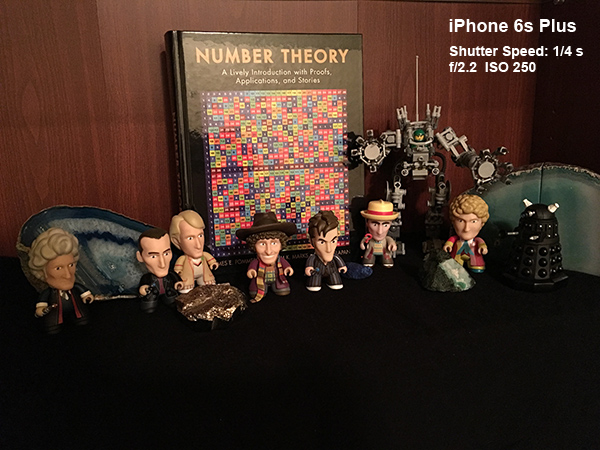

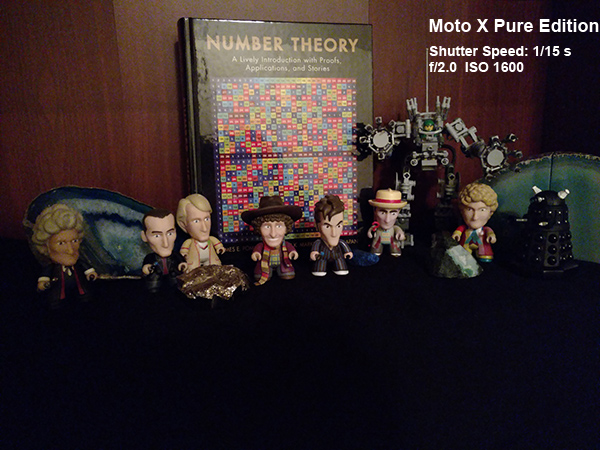






Full-Size Images: [OnePlus 2: indoor dark], [OnePlus One: indoor dark], [iPhone 6s Plus: indoor dark], [LG G4: indoor dark], [Moto X Pure Edition: indoor dark], [Galaxy S6: indoor dark], [OnePlus 2: indoor flash], [OnePlus One: indoor flash], [LG G4: indoor flash], [Moto X Pure Edition: indoor flash], [Galaxy S6: indoor flash]
All of the cameras handle this dimly lit scene differently. The Galaxy S6 and iPhone 6s Plus both do well with exposure, show a decent level of detail, and manage to keep noise low. The LG G4 utilizes its special low-light mode to capture more light, but misses badly on white balance, giving its image a strong yellow tint. The OnePlus 2's image also shows a yellow tint, although not nearly as bad. The OnePlus 2 slightly overexposes its image too. Image noise is similar to the iPhone 6s Plus and it maintains sharp details. The OnePlus 2's image is clearly superior to the OnePlus One's—which is too dark, too cool, too noisy, and out of focus—and the Moto X Pure Edition's—which is also too dark, too cool, and too noisy.
Most cameras produce similar exposures when using flash to light the scene. The exception is the OnePlus One, which lights the scene harshly and with a cool white balance. The Moto X Pure Edition and OnePlus 2 both produce more balanced shots with natural looking colors; however the edge goes to the Moto X for sharper detail and less noise.
The OnePlus 2's camera is a significant upgrade over the OnePlus One's. It generally does very well setting exposure and white balance, only faltering in our outdoor night scene. Image noise is pretty low, generally comparable to the iPhone 6s Plus, and its noise reduction is not so aggressive as to wipe away too much detail. The biggest issue we can find with the OnePlus 2's images is the relatively high level of JPEG image compression that creates noticeable artifacts around objects and edges. Fortunately, this is not a hardware issue but a poor preference in OnePlus’ camera app. Using a third-party camera app eliminates this problem. Other than its poor HDR mode, the OnePlus 2's camera compares favorably to other flagship phones.
-
ChuckUfarleys How much did Oneplus pay you for this inane review that is for a phone that is 6 months old?Reply
You reviewers NEVER bring up the terrible customer service, the terrible buggy Oxygen O.S., the constant everyday posts about how bad the Two is in their own forum.
Why would you even use the One for comparison, it's a TWO year old phone!
Why is that, are you too afraid to NOT recommend this phone? -
juanjovargas @ChuckUfarleys then a half-price and 6-months-old phone is comparable in terms of performance to the best phones of every brand? YESReply -
ctmk I rather get a redmi note.Reply
https://www.youtube.com/watch?v=gGLW-kzh6sI
the CPU is only effectively quad core 1.55ghz and will throttle to 800mhz in just few min of video soft decoding stress test. -
ubercake Looks like the new ZenPhone with its 3x optical zoom on the rear-facing camera may also be a looker in this price range.Reply -
Abdurrasheed Desai Lol the OP2s price just went down. It is more worth it now than it ever was.Reply -
mellis I still like my OnePlusOne. It also works great with Straigthtalk. No contract and no bloatware is the way to go! No way am I going to over $400 for a phone.Reply -
Spinachy Operating Systems all have security problems that need to be patched regularly. This is an important buying consideration for me. You do not mention on what schedule OnePlus will be patching the OS?Reply -
zvancu I own a OnePlus 2 and I have to say that I would wish that at least one of the reviews I see online would mention how terrible their customer support is. It seems that it's pretty common knowledge, but I never saw this before actually buying the phone.Reply
I have to say that at first I was happy with the device, but now I am having some issues with it and I contacted the support. At first they were stalling with some meaningless questions (like what's my IMEI even I had already provided it) but now I got to the point where they are simply ignoring me. It has been more then a week in which I wrote 5 messages and they did not even acknowledge that they saw them, not to mention actually doing something. -
jacobian The bottom line it seems, there is no need to upgrade if you already own a Oneplus One. I have one Oneplus One (64GB) in the family running the stock CyanogenOS, and I see no reason to upgrade it. Very good smartphone all around. Hope the next generation will be better.Reply